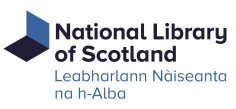Seminar: The Premodern Scottish Place: Mapping, Chorography, History, Landscape, Literature
To be held on 3 May 2024 in the National Library of Scotland's Causewayside Building, Edinburgh and online.
Introduction
This seminar brings together researchers working on the premodern (medieval and early modern) histories of Scottish cartography, chorography, landscape, history, and literature. In a series of presentations, the seminar will discuss some of the following (and similar) questions:
- what are the roles of the respective disciplines (mapping, chorography, landscape history, and literature) in the understanding of place and space in Scotland?
- what is the relationship between the premodern visual record (maps) and texts?
- what is the relationship between the (historical) lived experience of Scottish landscapes and their representations on maps and in other geographical texts and objects?
- what impact did the literary imagination have on the nascent sciences of mapping and chorography, and vice versa?
The seminar forms part of a wider research project relating to Place and Poetry in premodern Scotland. A related part of this project involves the creation of a new online resource, mapping a small selection of early modern poems relating to Scotland. We will unveil these on the day, inviting comment and review to help to finalise them by the summer.
The seminar will involve a series of short talks, with plenty of time for discussion. There will also be an opportunity to view a small selection of relevant collection items in the Maps Reading Room.
The seminar will be held on 3 May 2024 in the National Library of Scotland's Causewayside Building, Edinburgh (see location map), and also online. There will be no charge for the seminar, but you will need to reserve a place to attend.
This is a full-day event (10.30am - 3.10pm). For in-person attendees, coffee and tea will be available in the morning, and lunch will be provided.
Programme
10.00 coffee
10.30 start and welcome
10.45 Fiona Watson, The Farmer and the Cowman: Still not Friends in Medieval Scotland (25 mins)
11.10 Alfred Hiatt, John Hardyng's maps of Scotland in context (25 mins)
11.35 Roger Mason, Mapping with words: Descriptions of Scotland from Bower to Buchanan – and beyond (25 mins)
12.00 Questions and discussion (30 mins)
12.30 Lunch and viewing of collections
13.30 Sebastiaan Verweij, 'In wildirness & wilsum way': Mapping Wilderness in Premodern Scotland (25 mins)
13.55 Charles Withers, 'Poets make the best topographers'? Chorography, Poetry, and Map Making in Early Modern Scotland (25 mins)
14.25 (soft) launch of Place and Poetry 'Collaborative Project'
14.40 Questions, discussion and summing up (30 mins)
15.10 CLOSE
Abstracts and biographies
Fiona Watson
The Farmer and the Cowman: Still not Friends in Medieval Scotland
One of the striking aspects of the maps of medieval Scotland – none of which were constructed by natives, though at least some of the cartographers must have been able to interrogate those who were – is the preponderance of sites from eastern Scotland, especially its lowland plains. The north and west was, if not a dragon-infested terra incognita, certainly less understood with more than a hint of wildness and danger. As Dauvit Broun has shown, lowland attitudes to Gaels even before 1300 were very much about ‘the other’, and those others were barbarians. Although Professor Broun stresses the linguistic over the topographical origins of these attitudes, he does note that Gaels were deemed to inhabit ‘the mountains and outlying islands’ while those who spoke the Scottish version of English lived ‘by the sea coast and the plain.’ The other striking dichotomy which follows from this is that Gaels, living where they did, were largely pastoral, whereas non-Gaelic speaking Scots tended to be arable farmers. Using maps, poetry and place-names, this paper will explore the physical realities of the Gaeltacht, what was important – so far as we can tell – to its inhabitants, and how this was viewed from outside.
Fiona Watson is a freelance historian, writer, and presenter.
Alfred Hiatt
John Hardyng's maps of Scotland in context
The two maps of Scotland produced in the middle of the fifteenth century by the Northumberland chronicler John Hardyng are remarkable not only for their level of detail but also for their function as aids to an English invasion. The maps, which appear at the conclusion of Hardyng's verse Chronicle, certainly represent a departure from previous English mappings of Scotland, not least in their focus on a single kingdom of Britain. Yet how unusual were they within the context of regional map-making in fifteenth-century Europe? Through a comparison between Hardyng's maps and contemporaneous examples from France and Flanders, I will consider the possibility that the maps of Scotland in Hardyng's Chronicle may be representative of a strand of non-Ptolemaic, non-humanist regional mapmaking in the period.
Alfred Hiatt is Professor of Medieval Studies at Queen Mary, University of London.
Roger Mason
Mapping with words: Descriptions of Scotland from Bower to Buchanan – and beyond
The Scottish Latin chronicles of the 15th and 16th century – encompassing the works of Walter Bower, John Mair, Hector Boece, John Lesley and George Buchanan – all open with descriptions of the kingdom whose history they recount. This talk will examine how those descriptions became richer and fuller over time as each author brought different perspectives and accumulating knowledge to detailing Scotland’s topography, ethnography and chorography. Only Lesley’s text is actually accompanied by a map, but these verbal descriptions provide insights into how Scotland was conceptualised, not just as a territorial unit, but as a kingdom and nation. Although these Latin chronicles could only be accessed by an educated elite, this talk will conclude by considering the first vernacular description of Scotland, printed in the 1590s (a translation of Book I of Buchanan that fails to acknowledge its source), and how this was adapted and incorporated into a popular but largely neglected abridgment of the Scots chronicles by one John Monipennie, first printed in 1612, and reprinted on at least three further occasions in the 17th century.
Roger Mason is Emeritus Professor of Scottish History at the University of St Andrews.
Sebastiaan Verweij
'In wildirness & wilsum way': Mapping Wilderness in Premodern Scotland
'Extreem Wildernes': so Timothy Pont marked the area in northwest Sutherland around Loch Shin, where topographical detail gave away to emptiness. Earlier cartographers, e.g. Matthew Paris and the makers of the Gough Map, similarly framed Scotland's landscape and people by way of their wildness. In this talk I will explore the cultural connotations of wilderness as these emerge from mapping, chorography, and especially premodern poetry. Wilderness frequently figures as one extreem of a contrastive pair that always implies a spatial negotiation: wilderness versus civility; or the wild place versus home. I will consider how attention to wilderness helps us think more generally about place-making, and what rhetorical strategies were available to premodern writers in their depictions of the local. My talk will include discussion of several poems that set fictional speakers in real world Scottish landscapes, to think more about the contributions of poetic language to geographical thinking in this period.
Sebastiaan Verweij is Senior Lecturer in Late Medieval and Early Modern Literature at the University of Bristol.
Charles Withers
'Poets make the best topographers'? Chorography, Poetry, and Map Making in Early Modern Scotland
By the late sixteenth century, chorography was an established geographical art and practice in Europe. This illustrated talk will examine the nature and purpose of chorography, beginning (briefly) with Drayton's Poly-Olbion (1612). Attention will be paid to the place of poetry within chorography and that of chorography within English courtly culture, notably within the short-lived court of Prince Henry Frederick, son of James VI and I. In Scotland, the place of chorography and of topographic versification will examine the work (amongst others) of George Buchanan, Andrew Melville, Joan Blaeu and Sir Robert Sibbald's failed venture for a 'Scotish Atlas' in 1682. Consideration will be given to how contemporaries understood chorography and to how, today, we may interpret it as part of Scotland's geographical culture in the early modern period.
Charles Withers is Emeritus Professor at the University of Edinburgh and former Geographer Royal for Scotland.
Reserve a place
In person places are now fully booked, but you can reserve your place for the online seminar.


